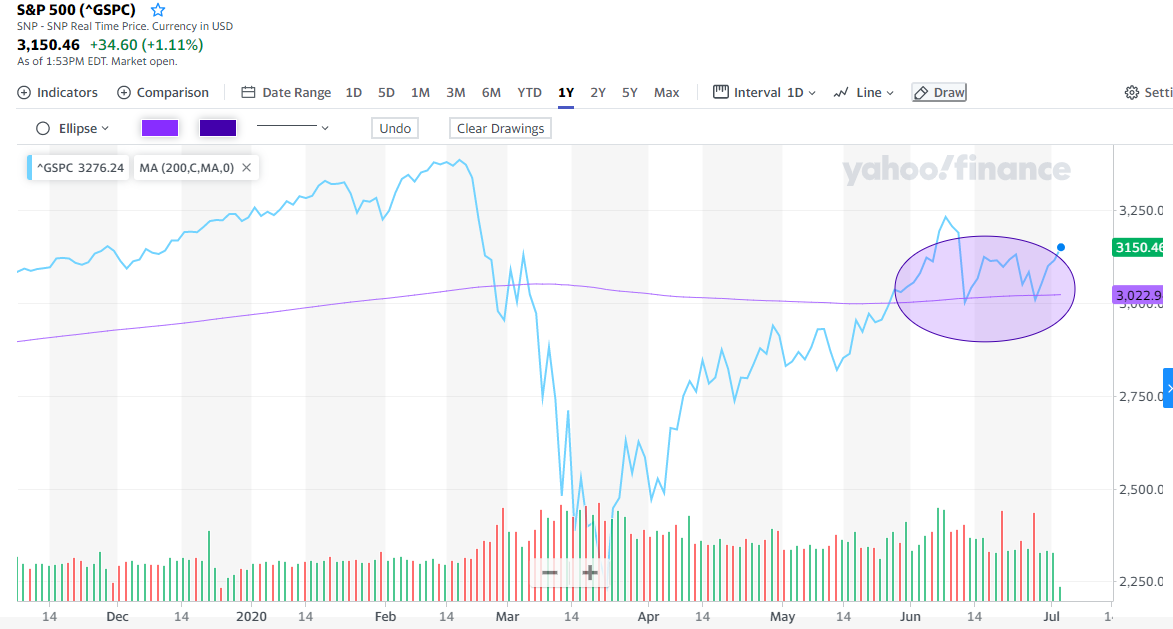What a difference a quarter makes! After one of the worst first quarters in recent memory, the S&P logged its best quarter since 1998, advancing over 20%. Bonds increased just under 3% for the second quarter of 2020. June was looking to be flat for the month, but the final two-day rally helped the S&P close up nearly 2% for the month while bonds were up .65%. Our two largest positions, QQQ and XLG were up 3% and 6.5% respectively for June.
The market continues to advance on hopes of a quick economic recovery, but there is still a lot of repair needed to get our economy and Main Street back to where it was pre-pandemic. The Fed’s ongoing commitment to support the market through monetary and fiscal policy is taking a front seat to lofty valuations in an environment where many constituents of the S&P 500 are removing earnings guidance. There is very little forward visibility on the pandemic’s ongoing impact on next year’s earnings. We will worry about valuation and potential inflationary impacts another day. For now, the focus squarely remains on continued Fed support, data points which continue to show improving economic activity, and the ongoing race to find a vaccine for COVID-19.
June 2020
For the last nine days of the month, the market had many up days but also two big down days on Wednesday, June 24th and Friday, June 26th, –both retreating 2.5% on ongoing concerns over the resurgence in COVID transmission and whether this would potentially stall the countries re-opening. Even on big down days, the declines stalled right at the 200-day moving average (MA) on Wednesday, and only breached the 200-day MA by 10 points from the selling pressure on Friday. The Monday, June 29th snap back quickly put the S&P back above the 200-day MA and continued its ascent from there.
The 200-day Moving Average (MA)
Again, the 200-day MA is simply the past 200 day’s closing price divided by 200. The MA is a smoothing mechanism which is widely used to determine the overall health and general direction of the market. When the market is above its 200-day MA and the 200-day MA is trending higher, the longer-term trend of the market is up. When the 200-day MA is trending lower, or the market trades below the 200-day MA, then the trend is down.
It is a positive sign that the market has re-tested this 200-day MA two times with both of those occasions snapping back above the market trend line after a small breach below (see chart below) confirming the idea that the trendline is proving support for the market. The more that the 200-day MA is challenged but holds as support, the more conviction market participants should have. This may further support a rising market, and barring a significant and sustained reversal of improving economic data points, a floor. We see the market continuing to be supported by net positive fund inflows, Fed liquidity that has to find a home somewhere (likely equities, as bond yields are so low and not a compelling place to capture yield), and the ongoing improvement in economic activity. We remain mostly invested to our target allocations.

May 2020
Consumer spending increased 8%, with PMI data, consumer confidence, and new home starts all ticking up in May, which data points to continued recovery, albeit gradual and within our expectation. None of this showing signs of a V-shaped recovery but ongoing bumps along the road.
Q2
For the quarter, our model conservative, moderate and growth portfolios appreciated 10%, 12% and 13.5% respectively. These returns captured some 75% of their respective benchmark rebounds for the quarter, when we gradually re-introduced risk into the portfolios off a sizable cash position at the close of the first quarter (when the market was in a freefall). We went down less in the first quarter and up less in the second quarter, leaving us in line with the respective benchmark, but taking 20% less risk in doing so.
This points to one of the benefits of tactical risk management and following an objective process. It allows us to ebb and flow with the market movements, protecting your assets when the market is decidedly negative, and growing your assets when the markets are trending higher. It is a gradual and proactive process, and we are not making big bets being all in or all out of the market. Having accumulated a sizable cash position during the first quarter was not at the expense of participating, to a sizable extent, the rebound during the second quarter. Remember, at the end of March we didn’t have the luxury of seeing the right side of the chart, and it was anyone’s guess whether the market would have continued to collapse at the height of the pandemic taking its hold of the global economies.
We still have some work to do to fully recover from the first quarter, as the S&P is still down 4% year to date, but we are pleased at the progress made over the past three months. As we look toward the second half of one of the most volatile market years in history, we remain optimistic that the economy can continue to improve.
We will continue to keep you updated on a regular basis on what is driving the market and any adjustments or allocation changes we make during each week. We are keeping an eye on the Fed’s potential announcements of another round of stimulus. While we do not expect as strong a rally as we saw in the second quarter, we are confident that the market can hold its ground as we approach the November election. We anticipate ongoing volatility as headlines move the market and likely little net progress over the next three months, we maintain our position that the market will likely be higher over the next 12 months
We hope you have an enjoyable July 4th weekend, and please stay safe, continue to practice social distancing and wear a mask when out in public.


